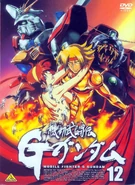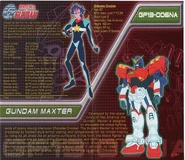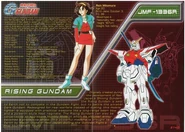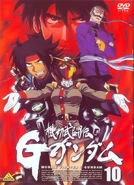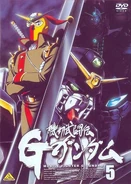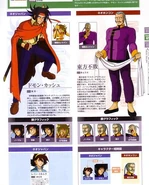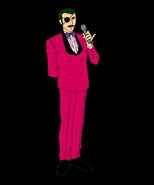(→Trivia) |
|||
| Line 131: | Line 131: | ||
* Mobile Fighter G Gundam is the only representative of Gundam series in ''Super Robot Wars Neo'' (Nintendo Wii), as there are only Super Robot titles in the game, while G Gundam is the only Gundam series that categorized as Super Robot. |
* Mobile Fighter G Gundam is the only representative of Gundam series in ''Super Robot Wars Neo'' (Nintendo Wii), as there are only Super Robot titles in the game, while G Gundam is the only Gundam series that categorized as Super Robot. |
||
| + | * It's been rumored that some of the sillier designs of the Gundams were made purely out of spite for Bandai/Sunrise's toy-centered policies as Imagawa disliked them (something he shared with Tomino). |
||
==See also== |
==See also== |
||
Revision as of 09:58, 11 December 2012
| Please note that this is the Gundam Wiki's article on the TV series, Mobile Fighter G Gundam; if you are looking for the article on the titular mobile suit of this series then you should head to GF13-017NJII God Gundam. |
"Anime" is not in the list (Manga, Novel, Game, Movie, OVA, Variation, Stage Play, Documentary, TV Series, Audio Drama, ...) of allowed values for the "Media" property.
Mobile Fighter G Gundam (機動武闘伝Gガンダム, Kidō Butōden Ji Gandamu) is a 49-episode anime series set in the Future Century timeline.
After Mobile Suit Victory Gundam finished airing in Japan in early 1994, Bandai commemorated Gundam's 15th anniversary by trying something new: developing the franchise outside the continuity of the Universal Century. Thus, the alternative worlds were born that are the settings for every TV series following Victory Gundam.
Premiering in 1994, Mobile Fighter G Gundam was the first of the alternative Gundam Universe series that would be unrelated to the Universal Century Gundam series. Directed by Giant Robo's Yasuhiro Imagawa, this series took a different approach to the Gundam saga. Rather than having a war between the colonies and the Earth, a fighting tournament is held. This is called the Gundam Fight, it is held once every four years by the United Colonies Federation. Each country would send its own representative, that would pilot a Gundam, and the Gundams would then fight on the Earth until only one is left, and that Gundam's nation will then be able to obtain sovereign rights over all the nations, until another nation wins in the next Gundam Fight. This series is set in Future Century (FC) 60, during the 13th Gundam Fight and it focuses on the Neo Japan Gundam Fighter Domon Kasshu, who is in the fight as much to win as well as fulfill his own mission of tracking down his brother, who had stolen a mysterious Gundam; the Devil Gundam from the Neo Japan government.
This series would also be controversial, as detractors criticize G Gundam as either an ugly parody of the Gundam world or a thinly disguised take on the Street Fighter/Dragon Ball Z/Fist of the North Star trend with the Gundam name Template:Cite. There is a following of G Gundam fans who liked its out of worldliness and willingness to play up exaggerated national stereotypes for comedic effect Template:Cite.
The TV show did not achieve high ratings in Japan. However, its model sales were strong, and Bandai has deemed the show a success. Also, after the inclusion of G Gundam in the Super Robot Wars games, it became very popular.
The G Gundam manga is published in English by TOKYOPOP, and the anime was licensed by Bandai Entertainment.
Rules and Regulations of the Gundam Fight
The following are the seven articles of the Gundam Fight International Regulations:
- A unit whose head section has been destroyed is disqualified. Supplement: Accidental harm inflicted on a Gundam Fighter during a match is acceptable.
- A Gundam Fighter must never aim at the cockpit of an opponent's Gundam.
- A Gundam Fighter may repair any damage to their Gundam as often as they desire and move on to the championship league, as long as the head section has not been destroyed.
- A Gundam Fighter must take full responsibility for protecting their own Gundam.
- A match shall only be held on a one-on-one basis.
- A Gundam Fighter shall not taint the honor and dignity of the nation they are representing.
- The Earth is the ring! Supplement: Destruction of property on Earth due to the Gundam Fight is not considered a crime.
Final Tournament Additional Rules
Upon the start of the Finals of the 13th Gundam Fight, Wong Yunfat debuted some controversial new rules:
- Unlimited repairs, improvements, and substitutions are acceptable during the final tournament.
- Victory may be obtained through any means (including targeting the cockpit).
- The final winner of the Battle Royale will be awarded the title "Gundam of Gundams."
Mobile Suits
Name changes
This series was aired on Cartoon Network starting in August 2002; however, many of the Gundams' actual names were changed for different reasons. Three of them were changed for religious references (partly due to the fact that Wal-Mart, the largest retailer in the United States, refused to stock toys of the XXXG-01D2 Gundam Deathscythe Hell during the run of Gundam Wing), one for an alcohol reference, and the rest for unknown reasons (some speculate that some of the names were too difficult for children to understand, while other names were changed to make them sound more appealing to young audiences). On the US DVD release, the original Gundam names can only be seen through English subtitles as the dubbed actors' lines are the same as the Cartoon Network version. The English manga also uses the new names.
| Original Name | English Adaptation |
|---|---|
| God Gundam | Burning Gundam (includes all the attacks that have the word God in them) |
| Devil Gundam | Dark Gundam (also the Death Army was changed to Dark Army and DG cells are referred as Dark Gundam Cells rather than Devil Gundam Cells) |
| Scud Gundam | Desert Gundam (only appears in a flashback at the beginning of Episode 2) |
| Tequila Gundam | Spike Gundam |
| Lumber Gundam | Grizzly Gundam |
| John Bull Gundam | Royal Gundam |
| Pharaoh Gundam IV | Mummy Gundam IV |
| Minaret Gundam | Scythe Gundam |
| Kowloon Gundam | Haow Gundam |
| Gundam Spiegel | Shadow Gundam |
| Nether Gundam | Hurricane Gundam |
| Matador Gundam | Toro Gundam |
| Nobel Gundam | Noble Gundam |
| Gundam Heaven's Sword | Raven Gundam |
In a related occurrence, Chibodee's oft-used friendly nickname for Domon, 'Japanese', was changed to 'Neo Japan' to avoid similarities to the racial slur 'Jap', a derogatory term to refer to someone of Japanese origin. Similarly, Chibodee's one-off use of 'Chinese' to refer to Sai Saici was changed to 'Neo China'.
Round 3 audio drama
The show's second soundtrack CD (although it is titled Round 3, as Rounds 1 & 2 were released as a two-disc album) contains an audio drama. In this brand new story, Domon and the others attend the premier of a Hong Kong action film based on their adventures. The story of both the film itself and the audio drama is mostly comedic in nature. One running joke involves Sai's annoyance that the film had cast him as a female and given Rain his place as Neo China's fighter. The drama segments are interspersed with the Catonese songs which were used to define the show's second half, set in Neo Hong Kong. A new one created for the album is a Catonese version of the show's first opening song Flying in the Sky, used as the opening song for the fictional movie. Domon is shown to quite enjoy the song.
The manga
A three volume manga was produced serialising the show, as authoured by Koichi Tokita. The manga has generally been poorly received by fans, mainly due to Tokita's characterisation of Rain Mikamura and how he ultimately paints her in an even worse light due to his own admitted favourtism of Allenby Beardsley. The manga is perhaps most famous for starting Go For It, Domon!, a series of 4-komas in which Tokita poked fun at the series. These continued throughout his Gundam works of the 1990s
Cameos
The final battle of G Gundam includes numerous cameo appearances by prominent mobile suits from previous Gundam series such as the original Mobile Suit Gundam, Zeta Gundam, Gundam 0083, Gundam F91, Victory Gundam version 2 and the manga Crossbone Gundam. In addition, this battle also featured appearances by Gundam Wing's XXXG-01W Wing Gundam (the first on-screen appearance of the Wing Gundam, as Gundam Wing did not actually air until after G Gundam was completed) and the title robots of Daitarn 3 and Zambot 3. In addition a mobile suit of striking resemblence to Gundam Deathsythe Hell (from the tv series) makes an apperance in episode introducing bolt Gundam in the underground facility. None of these machines played any significant role in the battle, and were likely included as an inside joke to long-time fans of Gundam.
Theme songs
- Openings
- "Flying in the Sky" by Hitofumi Ushima (episodes 1-25)
- "Trust You Forever" by Hitofumi Ushima (episodes 26-49)
- Endings
- "Umi Yori Mo Fukaku [Deeper Than The Ocean]" by Etsuko Sai
- "Kimi No Naka No Eien [The Eternity in You]" by Inoue Takehide
Trivia
- In the English version certain Gundams were renamed. However in episode 41 when the names and locations of the Gundams in the final Battle Royale are shown they are their original names. Domon's Gundam's name is shown as God Gundam and Gentile Chapman's is shown as John Bull Gundam.
- At the start of the second episode, Stalker (the show's narrator) welcomes the audience with an introduction that begins "I would like, if I may, to take you-". This is a reference to the same narration from the Rocky Horror Picture Show.
- The show is often mistakenly called 'Gundam G' by unofficial and fan sources.
- In a series of interviews for the official Region 1 American DVDs, Imagawa explains that Tohofuhai martial arts (the style practiced by Domon Kasshu and his mentor Master Asia) is so successful because rather than sticking to one particular fighting style it is constantly evolving and accepts successful elements from any and all known fighting styles.
- This series is set in the Future Century timeline. This made it the first Gundam series to be set outside of the Universal Century timeline from the original Mobile Suit Gundam series.
- In the last 2 episodes, when the Devil Colony Gundam makes its appearance, all the colony nations launch their Gundams to stop it. Among those in the battle are several suits from the shows prior to G-Gundam, including: the RX-78-2 Gundam from Mobile Suit Gundam, the GP-01 and GP-02 from Gundam 0083, the F91 Gundam from Gundam F91, the Victory 2 Gundam from V Gundam, and the Wing Gundam and Tallgeese from Gundam Wing, which was in production while G-Gundam was airing on Japanese TV. The Crossbone Gundam X-1 from the Crossbone Gundam manga is also present. Also appearing are the titular machines from three of Gundam creator Yoshiyuki Tomino's other anime: Zambot 3, Daitarn 3, and L-Gaim Mark II. Show Zama & Marvel Frozen of Aura Battler Dunbine appear in the Neo Japan Colony as well.
- In the third opening animation for the series, director Yasuhiro Imagawa can be seen in one of the Neo Hong Kong crowds wearing a Star Trek uniform.
- Mobile Fighter G Gundam is the only representative of Gundam series in Super Robot Wars Neo (Nintendo Wii), as there are only Super Robot titles in the game, while G Gundam is the only Gundam series that categorized as Super Robot.
- It's been rumored that some of the sillier designs of the Gundams were made purely out of spite for Bandai/Sunrise's toy-centered policies as Imagawa disliked them (something he shared with Tomino).
See also
| Preceded by: Mobile Suit Victory Gundam |
Production order 1993 – 1994 |
Succeeded by: New Mobile Report Gundam Wing |
Gallery
External links
- GundamOfficial page on G Gundam
- G Gundam Official Sunrise Inc Website (Japanese)
- G Gundam Entry on MAHQ
- English Online Streaming of Episodes on youtube

